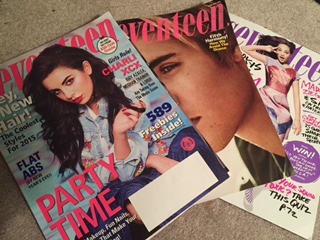Beauty is in the eye of the beholder

Seventeen Magazine, a widely read teen magazine, reflects societal standards of beauty.
“Beauty is in the eye of the beholder.” This phrase has been in our conversations and variations of art for centuries, but what does it truly mean? Different practices throughout history have been used to judge beauty, such as Tā moko or the art of facial tattoos. Traditionally, It was used to identify an individual’s personality, position in society, and was even seen as a mark of beauty. Other cultures around the globe have used practices of foot binding, neck rings, and ear elongation as other methods to judge levels of beauty. But where we differ in our method of measuring beauty, it may be just as morally wrong and obscene as you just judged the previously named practices.
The fairness of one’s skin tends to be the world’s oldest indicator of beauty. Centuries of painters have labored to capture this vision of beauty through dictions of goddesses – The Birth of Venus being one of the most famous. Unblemished, milky white skin with locks of long golden hair billowing about her in the ocean breeze. This vision of Venus is a mark that has been ingrained in our minds for decades, even centuries. Even in the recent past it has not been any different with a 2015 Hollywood Diversity Report indicating that 83.3% of lead actors in films released in 2013 were white.
While the Silent Generation, the Baby Boomers, and Generation X grew up in a world where globalization was limited and social norms were far more conservative, the Millennials, Generation Z, and the incoming Generation Alpha, have been born into a world with more diversity and open arms. Producing unmarked children, unburdened by The Birth of Venus, that will change and have already changed the vision of beauty. A study conducted at Cardiff University’s School of Psychology found “Overall, there was a 55 per cent chance that mixed-race faces were perceived as being more attractive than either black or white faces. But the ‘extremely attractive’ ratings were dominated by mixed race faces, who made up one in 10 of them”(Hope, Jenny). Continually, that group of people born of two or more races grew at a rate of 32% from 2000 to 2010 compared to those of a single race, that grew by 9.2%, stated by a 2010 census brief.
Slowly but surely, the stigma of perfection is evolving into one that represents the majority of individuals that longed to replicate these features in themselves but were “cursed” with a complexion that was too dark. In the future, the diversity that one can see in the media of the Millennial’s will one day be reflected on the cover of Vogue. Because beauty is in the eye of the beholder, Botticelli’s poetic Venus may just be painted again; this time, a few shades darker.

